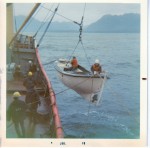Supplies for Cape Scott Lighthouse 1975

In 1975 we (myself, my wife Karen and our two young children, our dog, cats, and all our furnishings) were on our way clockwise around Vancouver Island from Quatsino lighthouse to Pachena Point on board the CCGS Sir James Douglas with acting Captain Tom Hull. This was a grocery run so the trip was already pre-planned and we were just passengers.
The seas were not high but as we rounded Cape Scott, the northern-most tip of Vancouver Island, we began to roll in the southwest swell. As we motored around into quieter waters on the inside of Vancouver Island, we were still being tossed around by occasional large ocean swells.
I had requested and received permission from the skipper to go ashore to visit the lightkeepers while the workboat made its numerous trips back and forth.
This was a grocery run – monthly tender of groceries and supplies from Victoria before the days of large helicopters. The skipper, Tom Hull, ordered the workboat into the water and to commence loading supplies for the lighthouse keepers at Cape Scott. The on-ship derrick lifted bonnet sling loads of material from the hold, over the edge of the ship and dropped it expertly into the rolling work boat tied up alongside the lee side of the ship.

Meanwhile, the swell tossed the tender and the workboat back and forth just to make the loading more difficult. The slings were covered with another bonnet sling to keep the contents dry from the salt spray.
The workboats were double-ended fibreglass-over-wood clinker-built designs, not much bigger than a standard ship’s lifeboat. They were seaworthy but rocked and rolled all the time. They were driven by an internal diesel engine with a through-hull shaft and external caged propeller. The direction was controlled by an outboard tiller.
When the first loading was finished , I climbed down the shipside rope and wood ladder and jumped into the clear space aft where the mate was controlling the motions of the boat. The crew threw off the lines and we headed for Vancouver Island, still rolling and tossing in the swells. At times the Douglas disappeared from view as we wallowed closer to shore and into the narrow cut which was the entrance to the landing at Cape Scott.
Inside the cut the water was white and green and tossing up onto the rocky shore. High above I could see the winch shed and the lightkeepers waiting and watching as the workboat nosed into the shore. By this time I had moved into the bow of the boat and as the swell rolled us towards the rock I was told to “Jump!” Luckily it was near high tide and the rocks were not too slimy with seaweed.
I made it ashore and climbed the peaty trail to the top. The view into the gorge was spectacular. It was dark but lit by a clear sky and the whiteness of the white foam from the moving green sea. I greeted the keepers and admired the fact that they had a truck to haul their groceries and supplies back to the lighthouse. Some stations only had a wheelbarrow!
The workboat had finished unloading as I made it slowly to the top and had returned to the ship for another load. The radio blared that the workboat was on its way in again and the keeper got ready on the winch.
One could not see the workboat until it entered the cut and by then it was rolling even more than usual. As it came in it tried to make the right hand turn to align itself with the hook (of the highline) but at the same time a large swell doubled up on itself and lifted the boat and crew and deposited them on the rock at the right entrance to the cut.

As the swell receded, the boat was left high and dry and proceeded to roll over on its side and spill all the groceries and supplies into the sea. The crew were hanging onto the gunwales as the next swell came in, righted them, and swept them off the rock back into the main water, the caged propeller still turning.
Control was established. The pumps were working as they called me back to the workboat and we headed soggily back to the Douglas.
Captain Hull gave as much as he could from the ship’s stores to help replace some of the missing groceries and the workboat made one last trip in to resupply the keepers. This was to last the keepers for the next month while the ship could be re-supplied in a few days in Victoria.
We moved out of the rough waters as soon as the workboat was back on board. The high tide and the swell really made it uncomfortable at this anchorage. An overnighter in Port Hardy dried everything out.
**********************************
To see what life was really like in the ship’s workboats, check out Reg Gunn’s article Life in the Canadian Coastguard. Reg was first mate on the CCGS Sir James Douglas in the days before helicopters.
I saw a sir james douglas anchored in napier bay off wells passage
june 8 2012.
Is this still a working coast guard ship ?
It was in a logging area .
Norah
Interesting Norah! I had not been following the life of the ships – maybe something I should add to my website. Anyways, after a bit of searching I found the following “In 1993 laid up at Victoria BC. In 2003c she was struck from the register” form Nauticapedia, so it looks like it was retired. The CG website with active ships does not list it either. Coast Guard Fleet search
Thanks for the information. Did you get a photo? If so, i would love to see it.